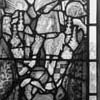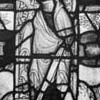Corpus Vitrearum Medii Aevi
Medieval Stained Glass in Great Britain
Your trail:
- CVMA Publications
- Norfolk: Guestwick, Parish Church of St Peter
Norfolk: Guestwick, Parish Church of St Peter
O.S. TG 061270
Document Contents
Nave
South aisle
sV.
1b. Centre: a group of fragments, including the head of a man facing to dexter and wearing a straw hat, with grotesque features, including a straggly beard and bushy eyebrows; trace-line, matt wash; grey-white glass, with black paint and yellow stain; cracked and dirty on the lower half. There is also a sun-burst (cracked); a pair of hands, one holding the head of an arrow; a raised hand against part of a glory; a hand holding a globe, presumably that of God the Father; the neck and long hair of a female figure; all with trace-line and in white glass, with black paint and yellow stain. Also the dark-murrey body of a ?devil; part of a wing or feathered limb, with worn yellow stain; blue drapery; and plain ruby. To either side is a large eyelet filling with foliage decoration; trace-line, cross-hatching; white glass, with black paint and yellow stain.
Centre of the upper part: the lower section of a feathered angel, probably a seraph, standing on a chequered pedestal; trace-line; white glass, with black paint and yellow stain. Immediately above is part of a headless musical angel wearing feathers and a gown with a tippet decorated with leaves, facing to sinister and playing a harp; where the head should be is part of a larger nimbed head with a turban and brooch. To the left of this are more feathers and a nimbed head set against a glory, probably part of a Nativity of Christ. To the extreme left is a hand holding a staff. Top left and right are fragments of canopy work and blue seaweed diaper and cloud.
Centre of the lowest section: a fragment of micro-architecture showing a quarried window set in a buttressed wall. To the right of it is a fragment of a figure of St Agnes, facing to sinister, with a dagger in her neck and a lock of her long hair. To the left is what may be part of the same image, depicting the left foot and the bottom of her long hair, which legend says grew long to cover her nakedness. 5 There is also a fragment with a similar lock of hair and some fingertips. On the extreme left is a piece of seaweed diaper on white glass, and to the right, a fragment of an ears-of-barley pedestal. Bottom left is an irregular fragment with a quarry pattern, and to the right, part of a foliage eyelet with seaweed pattern. Also some blue drapery.
All this glass is of the same date, c.1445 – c.1455.
h 0.72m, w 0.375m (without fillet of white
glass)
2–3b. Centre of the lower part of the panels: a complete tracery light with a figure of St Catherine of Alexandria. She stands, facing to dexter, crowned and nimbed, against a seaweed diaper screen on an ears-of-barley pedestal, wearing a white mantle over a ruby robe, holding a sword pointing downwards in her left hand and the spiked wheel in her right. In the head of the light is a plain blue background. Trace-line and matt wash with relieving. White glass, with black paint and yellow stain. The bottom of the robe is patched with pieces of ruby, there are several repair leads, including some across the face, and there is light to medium external corrosion, heavier on the patched drapery.
To the left of this figure: fragments include pod ornament; drapery; a fragment of a female figure wearing a white mantle and holding her long hair with her left hand; perhaps from a figure of St Mary Magdalen; a delicate rinceaux diaper; part of a patterned quarry; a face of a man showing signs of leprosy, perhaps from the recorded depiction of the Corporal Acts of Mercy; ruby glass; part of a wooden beam; and pieces of canopy. 6 To the right of this figure: foliage decoration, some unidentified ornament, a sexfoil, a grotesque head, blue glass, part of a patterned quarry, part of a wooden beam, ruby glass, and canopy fragments. Above the figure: further sections of canopy with blue and ruby backgrounds.
The upper third of these two panels is dominated by a tracery-light figure of a bishop or abbot standing against a seaweed screen on an ears-of-barley pedestal, facing to sinister and wearing, unusually, a white mantle with decorated collar and morse over a white robe, with gloves, and holding a crozier in his left hand and blessing with his right. The head has been replaced by that of a bearded man with a ruby hat, partly modern. It is possible that this is a composite figure, as no vestment is worn, and the piece depicting the upper part of the torso is much more corroded. However, the seaweed screen, on which drapery and crozier are painted, does appear to fit. Trace-line and matt wash, with relieving. White glass, with black paint and yellow stain. Above the screen is a blue background.
To the left of this figure: part of a staff piercing a dragon’s mouth, from a figure of St Margaret; a gloved right hand wearing rings and blessing against a seaweed screen, from another depiction of an abbot or bishop; part of a crozier against the right side of a seaweed screen, perhaps part of the same figure; part of a vase, perhaps originally with lilies, from an Annunciation; and a fragment with a hand coming out of a fur-trimmed sleeve. To the right: the lower part of a female figure wearing an apron or plain gown, with the left hand; a spiked wheel from a figure of St Catherine; part of a nimbed and crowned head against a seaweed diaper screen, perhaps from the St Margaret figure; white drapery; and part of a patterned quarry.
Except for the modern ruby on the hat, all this glass is of the same
date, c.1445 – c.1455.
h 0.82m, w 0.375m (without fillet of white
glass)
4b. Most of the panel is very corroded, almost opaque white glass, with
no discernible design; to either side are
fragments of canopy and a patterned quarry
cut to a circle. c.1445 – c.1455.
h 0.245m, w 0.375m (without plain fillet)
sVII.
1b. The only reasonably coherent section is part of a figure of a bishop wearing a decorated alb with gloved right hand with four rings raised in blessing. Trace-line, matt wash. White glass, with black paint and yellow stain. At the base of the panel are some very corroded fragments, including a chequered pattern with rosettes on white glass with yellow stain. Above them is canopy work; blue and white drapery; seaweed diaper; and two pieces with bare feet, one on a seaweed diaper. In the centre of the next section upwards is part of a figure lying in bed, probably from the recorded series of the Corporal Works of Mercy. Nearby are some pieces of very pitted ruby, some white drapery with a rosette pattern, blue and orange drapery, a hand holding a book, two hands joined in prayer, and a piece of white drapery with a rosette pattern. There is one piece of green relieved hawthorn diaper of c.1300 – c.1350.
To each side of the bishop is a large foliage eyelet filling; trace-line, cross-hatching; white glass, with black paint and yellow stain. Other fragments include parts of two palliums from figures of archbishops; part of a saw against drapery from a figure of St Faith; a hand holding a rod, perhaps part of a sceptre; the leg of a feathered angel; blue and ruby drapery; blue cloud; canopy; a roundel with a faded design; and part of a glory originally glazed into a foil.
Except for the hawthorn diaper, all this glass is of the same date,
c.1445 – c,1455. Some of the white glass in this panel suffers from
medium to heavy external corrosion.
h 0.745m, w 0.375m (without plain fillet)
2–3b. The central feature is a tracery light panel with the figure of a bishop standing facing to dexter against a seaweed-diaper screen with an ears-of-barley pedestal. He is nimbed, mitred, and gloved, and wears a white chasuble with decorated collar and morse over an alb. Above the screen is a ruby background.
Below the bishop: part of a feathered angel in mantle and tippet playing a double pipe or double shawm, and pieces of canopy, including a lion. 7 To the left of the bishop: the head of a bearded old man holding his head and wearing a close-fitting bonnet, perhaps from the series of the Corporal works of Mercy, set on ruby fragments, and parts of two patterned quarries. To the right: a grotesque head in purple glass set against fragments of blue glass, including drapery, and parts of two patterned quarries.
Above the bishop: the substantial remains of a canopy top with ruby
and blue backgrounds, mostly not original. At the top below the
springing is a rather fragmentary figure of a patriarch
or prophet standing against a seaweed-diaper screen
on an ears-of-barley pedestal, wearing a white mantle over a ruby
robe, gesticulating with both hands. The panel is painted from the
same cartoon, but reversed, as the patriarch in nVI A4 at Stody, and
comparison with this shows that the head, here replaced by a female
saint’s head, was originally in profile, bare-headed, with the hood
thrown back. Above the screen is a blue background. Trace-line, matt
wash. White and blue glass, with black paint and yellow stain. The
rest of this section is mainly filled with fragments of canopy work,
but there is also a part of a figure with a book. All this glass is
of the same date, c.1445 – c.1455.
h 1.215m, w 0.36m (without plain fillet)
4b. An area of almost completely opaque glass with parts of a
canopy top left and right, with a blue
background. At the top a crocketed finial and two patterned quarries
cut into circles; the one on the left is probably new. c.1450 –
c.1460, unless stated.
h 0.33m, w 0.36m (without plain fillet)
Footnotes
- 5.
- Both fragments can be paralleled in a figure of St Agnes now in a private collection in Memphis, Tenessee; see Raguin 2006, pp. 193, 194, 198–99. I am grateful to Virginia Raguin for sending me a copy of this exhibition catalogue. See also Corpus Vitrearum, Checklist III 1989, p. 224. The legend of the miraculous growth of St Agnes hair is in Serjeantson 1938, pp. 119–20. Return to context
- 6.
- I am grateful to Carole Rawcliffe for identifying the symptoms of leprosy. Return to context
- 7.
- Rose 2001, pp. 204–205. Return to context

